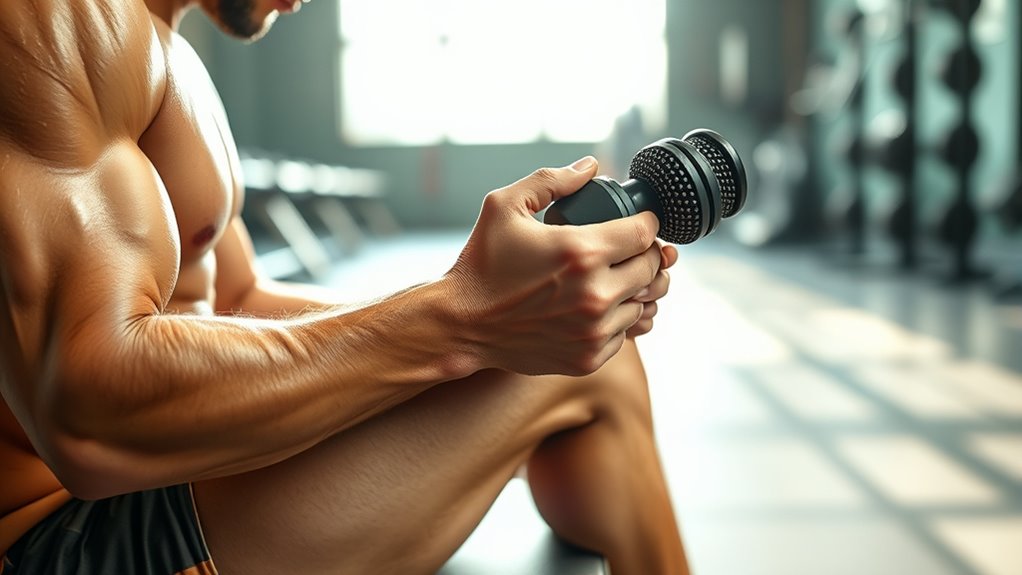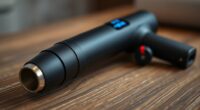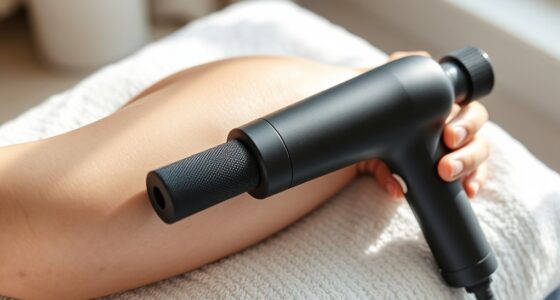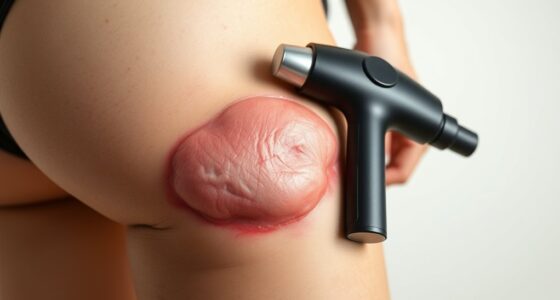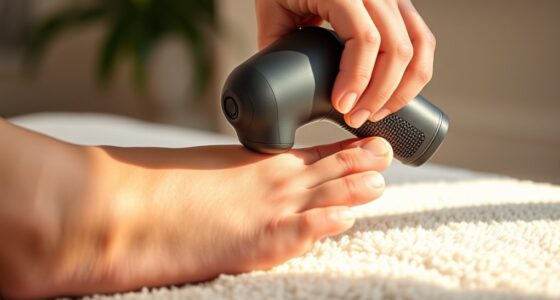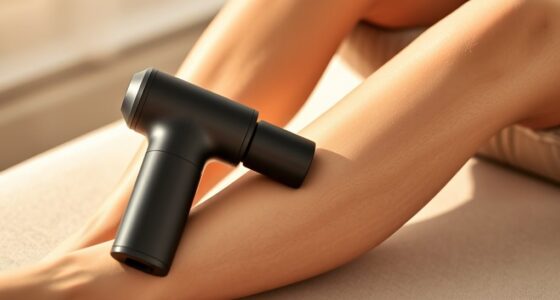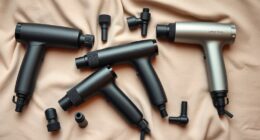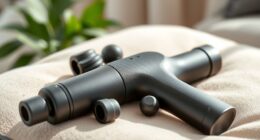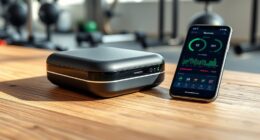Percussive therapy helps you recover faster by boosting blood flow, reducing muscle soreness, and promoting relaxation. It targets specific muscles with rapid, repetitive tapping that loosens tightness and breaks down waste buildup. Many athletes love it because it minimizes injury risk, improves flexibility, and enhances their overall performance. When used regularly, it supports quicker healing and keeps you in top shape. Keep exploring to discover how to make the most of these benefits.
Key Takeaways
- Percussive therapy increases blood flow, accelerating waste removal and nutrient delivery for faster muscle recovery.
- It reduces muscle soreness and stiffness, helping athletes return to training more quickly.
- Mechanical pulses interrupt pain signals, providing immediate relief and enhancing pain modulation.
- Regular use improves tissue flexibility, lowering injury risk and supporting sustained athletic performance.
- Easy integration into routines allows targeted muscle relief, promoting quicker healing post-exercise.
Understanding Percussive Therapy and Its Mechanisms
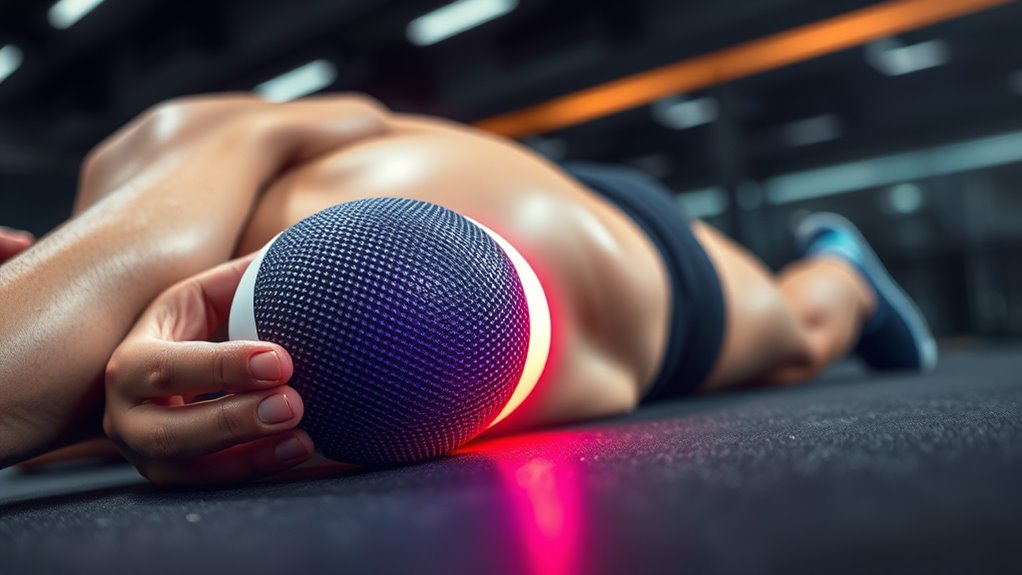
Have you ever wondered how percussive therapy works to relieve muscle tension? This treatment uses rapid, repetitive tapping motions that target specific muscle groups. When you use a percussive device, it stimulates your muscles through mechanical pulses, promoting muscle relaxation. These pulses help to increase blood flow, which aids in flushing out metabolic waste and delivering nutrients essential for recovery. Additionally, percussive therapy influences pain modulation by interrupting pain signals and reducing discomfort. This combination of mechanical stimulation and improved circulation helps loosen tight muscles and decrease soreness. As a result, you experience less tension and a quicker return to ideal muscle function. Understanding these mechanisms highlights why percussive therapy is a powerful tool for athletes seeking faster recovery. Moreover, attention plays a crucial role in maximizing the effectiveness of this therapy by ensuring consistent application and focus during treatment.
The Benefits of Percussive Therapy for Athletic Recovery
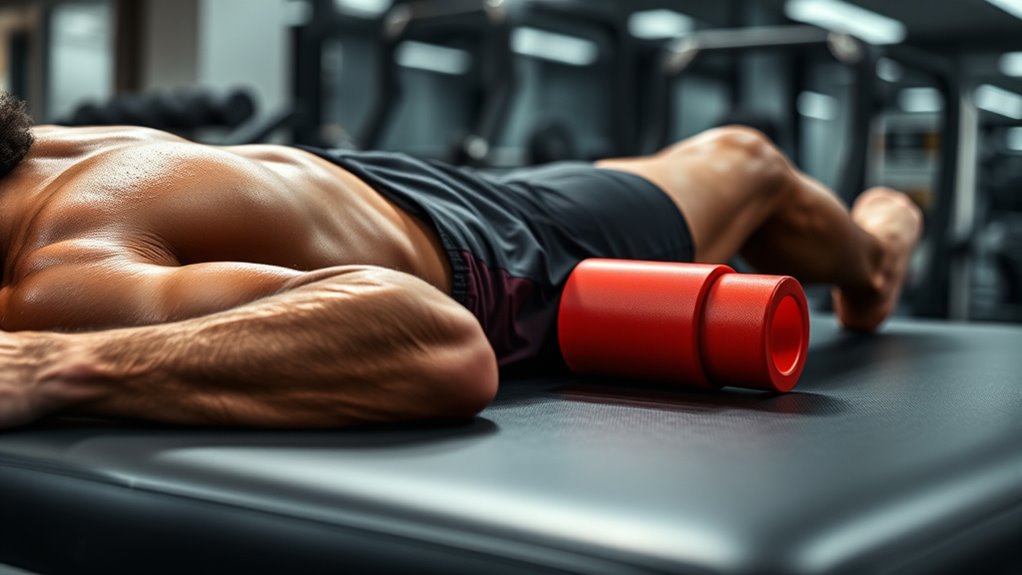
Percussive therapy offers a range of significant benefits that can accelerate your athletic recovery. It helps improve muscle flexibility, allowing your muscles to move more freely and reducing stiffness. This therapy also sharpens your mental focus, keeping you alert and motivated during training. Additionally, it:
- Eases muscle soreness by breaking down lactic acid buildup
- Enhances muscle relaxation, preventing injuries
- Reduces tightness that hampers your performance
- Promotes quicker recovery between workouts
- Understanding regional resources can help you find local experts to guide your recovery journey.
How Percussive Devices Enhance Blood Flow and Reduce Soreness

Using percussive devices can increase your blood flow quickly, helping your body deliver nutrients and remove waste more efficiently. This boost in circulation accelerates healing and reduces soreness after intense workouts. By improving your blood flow, you’ll feel relief faster and support your recovery process. Additionally, enhanced circulation fosters a sense of well-being by promoting active listening and empathy, which are key components of effective communication.
Increased Circulation Boosts Healing
When percussive therapy devices deliver rapid, targeted pulses to muscles, they markedly increase blood flow in the treated area. This enhanced circulation accelerates healing by delivering oxygen and nutrients more efficiently. As a result, you can experience faster recovery and reduce muscle fatigue. Here’s how it helps:
- Promotes the removal of metabolic waste, decreasing soreness.
- Improves tissue elasticity, supporting injury prevention.
- Stimulates blood vessels, increasing overall circulation.
- Enhances the delivery of healing compounds to damaged tissues.
- Energetic alignment can further optimize recovery by fostering a positive mindset and emotional balance that supports physical healing.
Soreness Relief Through Percussion
Enhanced blood flow from percussive therapy plays a key role in alleviating muscle soreness after workouts. By increasing circulation, your muscles receive more oxygen and nutrients, which speeds up recovery and reduces stiffness. This improved blood flow also helps break down lactic acid buildup, easing soreness and promoting muscle flexibility. When muscles are more flexible, you’re less prone to strains and injuries, making your training safer and more effective. Percussive devices target tight, sore areas directly, providing rapid relief and restoring movement. Regular use not only diminishes soreness but also enhances overall muscle health, supporting injury prevention. Additionally, improving muscle flexibility can contribute to noise reduction during recovery, making your post-workout routine more comfortable. If you want to bounce back faster and keep soreness at bay, incorporating percussion therapy into your recovery routine is a game-changer.
Real Athletes Share Their Success Stories With Percussive Therapy

Many athletes have found that percussive therapy markedly boosts their recovery and performance. They share how it helps reduce muscle tension and prevent injuries, keeping them in top shape. Here are some success stories:
- A marathon runner improved recovery times, feeling more relaxed and ready for the next race.
- A weightlifter minimized muscle tightness, allowing for better range of motion and strength gains.
- A cyclist avoided common overuse injuries by incorporating regular percussive sessions.
- A soccer player noticed faster healing after intense matches, staying on the field longer.
- Understanding the family background of athletes can offer insights into their motivation and support systems, further explaining their dedication to recovery routines.
These real athletes emphasize how percussive therapy supports injury prevention and eases muscle tension, making it an essential part of their training routines.
Incorporating Percussive Therapy Into Your Training Routine
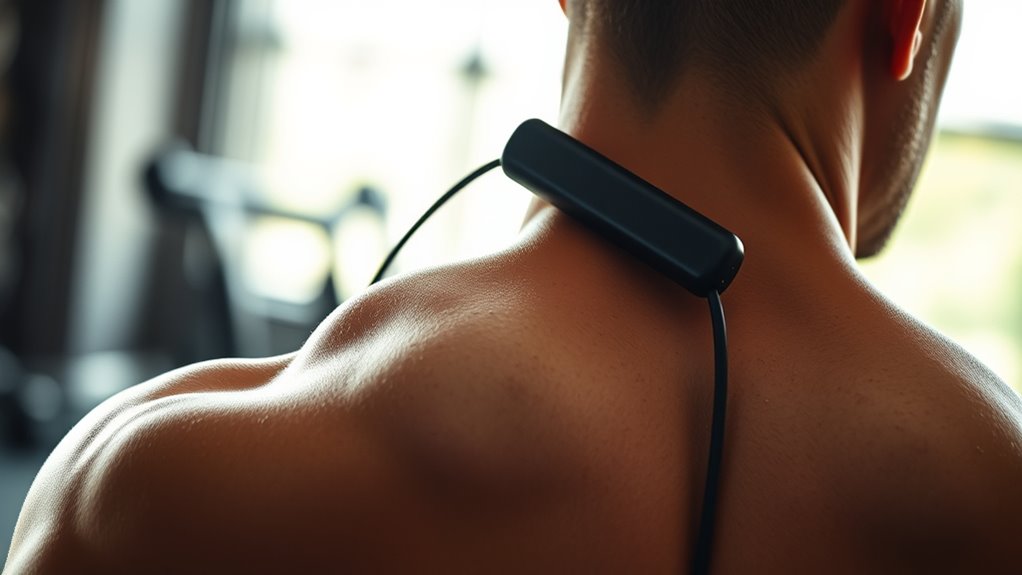
Incorporating percussive therapy into your training is simple and can be done with minimal disruption. Focus on targeted muscle relief to reduce soreness and improve flexibility. By doing so, you’ll enhance your recovery efficiency and stay ready for your next workout. Using devices with multi-functionality, such as those combining percussion, massage, and heat, can further optimize your recovery process.
Easy Integration Methods
Integrating percussive therapy into your training routine is straightforward and can be tailored to fit your specific needs. It helps reduce muscle tension and supports injury prevention with minimal effort. To get started:
- Use the device post-workout to relax tight muscles and improve circulation.
- Incorporate brief sessions before training to prepare muscles and prevent injury.
- Target specific areas with focused therapy for maximum muscle tension relief.
- Combine percussive therapy with stretching for enhanced recovery and flexibility.
- Be mindful of side effects of overuse, such as soreness or discomfort, to ensure safe application.
Targeted Muscle Relief
Are you targeting specific muscles for ideal recovery and performance? Percussive therapy allows you to focus directly on areas prone to muscle fatigue, helping break up tension and boost circulation. By applying targeted percussive treatments, you can reduce soreness and restore muscle function faster. This precise approach not only speeds recovery but also plays a key role in injury prevention, as releasing tightness minimizes strain and reduces the risk of strains or tears. Incorporating percussive therapy into your routine ensures you’re addressing problem areas proactively, keeping muscles healthy and ready for your next workout. Customizable options in percussive therapy devices make it easier to tailor treatments to your unique needs. Whether recovering from intense sessions or preparing for competition, targeted muscle relief with percussive therapy keeps you in top form and minimizes setbacks.
Enhances Recovery Efficiency
Adding percussive therapy to your training routine can substantially boost recovery efficiency by accelerating muscle repair and reducing downtime. It promotes muscle relaxation, helping your muscles recover faster after intense workouts. Incorporating this therapy can also aid in injury prevention by addressing tightness and imbalances early. To maximize benefits:
- Use percussive devices regularly to target sore or tight muscles.
- Focus on muscle groups prone to injury or tension.
- Incorporate sessions post-workout to speed recovery.
- Combine with stretching for enhanced muscle relaxation.
- Be aware of beauty store hours and schedule your recovery sessions accordingly to fit into your routine.
This approach minimizes soreness, prevents injuries, and keeps you training consistently. By integrating percussive therapy, you optimize your recovery process, ensuring you’re ready for your next challenge faster and more effectively.
Choosing the Right Percussive Device for Optimal Results
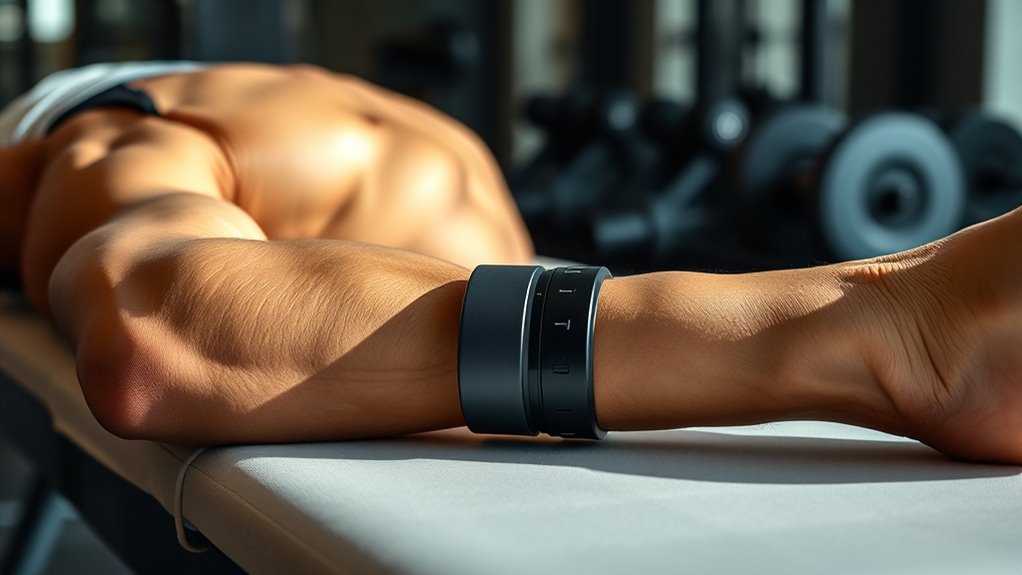
Choosing the right percussive device is essential to maximize your recovery and performance. You want a device that’s durable, so it withstands frequent use without breaking down. An ergonomic design ensures comfort during long sessions, reducing strain on your hand and wrist. Consider your specific needs: do you prefer a lightweight tool for portability or a more powerful device for deep tissue massage? Additionally, understanding contrast ratio helps in selecting devices with effective power settings for different muscle groups.
Frequently Asked Questions
How Often Should Athletes Use Percussive Therapy for Best Results?
Think of your muscles as a garden needing regular tending. For best results, follow the frequency guidelines that suit your activity level, typically 3-4 times a week. Use percussive therapy during ideal timing—post-workout or when muscles feel tight—to help release tension and boost recovery. Listen to your body’s signals, and adapt your routine accordingly, ensuring each session nurtures your muscles back to strength and flexibility.
Are There Any Risks or Side Effects Associated With Percussive Therapy?
You might wonder if percussive therapy has risks or side effects. While it’s generally safe, you could experience muscle soreness or skin irritation if used improperly or too aggressively. Always start with gentle settings and avoid sensitive areas like bones or joints. If you notice persistent discomfort or irritation, stop use and consult a healthcare professional. Proper technique helps minimize risks and maximizes benefits, ensuring a safe recovery.
Can Percussive Therapy Replace Traditional Stretching or Massage?
Think of percussive therapy as a modern-day Thor’s hammer for your muscles. While it’s great as a stretching alternative and offers a quick massage comparison, it doesn’t fully replace traditional methods. Stretching helps maintain flexibility, and massage improves circulation, both essential for long-term health. Use percussive therapy to complement these techniques, not replace them, ensuring a balanced approach to recovery and injury prevention.
Is Percussive Therapy Effective for Injury Prevention?
Percussive therapy is effective for injury prevention because it boosts muscle activation and enhances circulation. By stimulating muscles, it helps you identify tight areas before they cause problems, reducing injury risks. The improved blood flow also promotes faster healing and keeps your muscles healthy. Incorporate percussive therapy into your routine to maintain ideal muscle function, prevent injuries, and stay at your peak performance levels.
What Training or Certification Is Needed to Professionally Administer Percussive Therapy?
Ever wonder what it takes to professionally administer percussive therapy? You’ll need to meet certification requirements, which often involve completing specific professional training programs. These programs teach you proper techniques, safety protocols, and anatomy knowledge. Certification varies by region and provider, so it’s essential to select accredited courses. By obtaining the right training, you guarantee effective and safe treatment, helping clients recover faster and prevent injuries confidently.
Conclusion
Just like a trusted coach guiding you through every hurdle, percussive therapy accelerates your recovery and keeps you in the game. By integrating this powerful tool into your routine, you unseal your body’s potential—much like a phoenix rising from the ashes. Embrace the rhythm, trust the process, and watch soreness fade as you soar toward peak performance. Remember, with consistent use, you’re writing your own comeback story—stronger, faster, and ready for anything.
